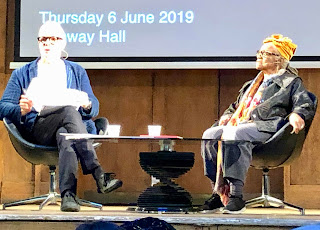Faith Ringgold's exhibition at Serpentine Gallery opens today 6/6/19.
Her beginnings. Young children love art - they practice and do art. Often they keep at it until 12/13, then give up because they are not encouraged. Not seen as proper work/education. Becoming an artist is a real challenge. Doing leads too Being.
Harlem was an extended family and was very protective. She was born in 1930. She knew ordinary people, normal people who were unknown artists who became well known. But they were just ordinary people. John Hendricks, Jean Toche. Recognition of black people. Not many went to college but the feeling of the time was that 'going to college' meant you could be something.
There was no degree in art for itself at that time, but she could get a degree in order to teach art. It was a boys school, the city college. She could only go to the city college in order to become a teacher, because she was a girl. She could major in art, and minor in teaching, to get her place. Interesting that teaching was not deemed to be a major endeavour!
Enriching, interesting and wonderful. Enjoys meeting other artists who have gone before her.
American People Series 1963. Martha's Vineyard. Her experience - black peole were not to paint white people, but it was ok for whites to paint blacks. Postage stamp is her version of Picasso's Geurnica.
There were spontaneous riots in the USA at this time - but not put on tv. Hale Woodruffe insulted her work - work has no rhythm. (Since when did black people not have rhythm!) She did it her way. Showed her rhythm. Huge abstracts were in vogue - her work was huge and figurative. Her work is now shown in MOMA. Her Geurnica is the most visited artwork in the show.
'Black' as a word was feared by black people. Then Black Power in 1966 changed all that.
She moved into activism in late 60s/70s. Political art is art. It is not to be thrown away or despised. Something to think about. Freedom and how important it is. United States of Artica - stats of dreadful things.
Protested at the Whitney (when? 30 years ago?) - demanding women artists to be displayed. The Biennale showed few women, and very few black women. Decided to ask for %. Michele (who?) - very young black artists suggested 50%, which they put on their placards. This resulted in 23% women's images being selected (but only 2% black women). This year 50% women shown.
Story Quilts.
Constantly told 'not your story'. But it is the story of those around her. Publish 'my' book her way. Growing up in Harlem was good - her stories are not misery literature. Wrote it on her art. Freedom of speech on her quilts. Took 15 years to get published. Bullfinch Press published it first. Then Duke University Press. Writing over her art helped get published. Has written many childrens' books. Tar Beach comes from the script on a quilt.
Metro art. Her work is on the NY Metro at a couple of stations. She needed to appear with the imagery before people took notice. It's not about the idea, but you need to show what it is.
Work hard. Don't change what you do. Don't try to please others. Please yourself with your art. That's the key. You will be successful at that, rather than following someone else's ideas/instructions.
Why quilts - black slaves were allowed to make quilts as they could keep the master warm! One art form can turn into another.
Great evening. Very interesting to see who was in the audience. Young black men and women; middle aged black women, and elderly white women (quilters). VERY enthusiastic response from audience. Very important that she had told the political narrative of black people. Really showed the need for non-mainstream narratives in art. Fantastic evening.


No comments:
Post a Comment